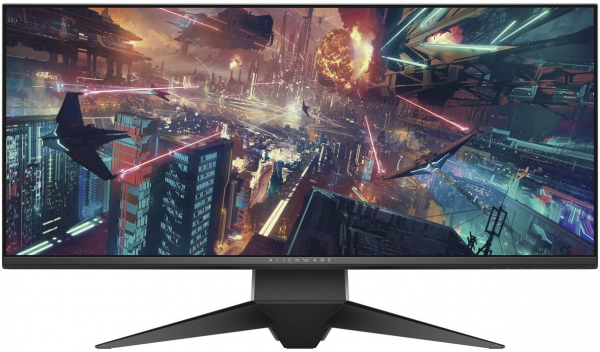Alienware
AW3418DW: the Alienware panoramic monitor
Aprox. 765€
See specificationsAnnounced last August, the Alienware panoramic monitor has finally found its way to our laboratory to suffer the lightning strikes from our measurement tools. So let's see if the Alienware monitor is competitive ...
Positive points
Good size / definition ratio.
120 Hz G-Sync compatible.
Good reactivity for IPS.
Open viewing angles.
Ergonomics.
Finish.
Bad points
Modest contrast.
No backlight scanning (ULMB).
Limited video connectivity.
Unreliable gamma.
Our review
Presentation
The Alienware AW3418DW monitor has a 34-inch (~ 86 cm) panoramic IPS panel, curved over a radius of 1.9 m (1900R), displaying a comfortable UWQHD definition of 3440 x 1440 px and with native refresh of 100 Hz The manufacturer announces a response time of 4 ms, a contrast of 1000: 1, a brightness of 300 cd / m² and a coverage of 99% of the sRGB color space. Alienware obliges, it has some LEDs on board to give it a little more cachet, but Alienware is unfortunately no longer alone on this niche and many players have started to use RGB lighting.
Sold for around € 1,100, the Alienware AW3418DW monitor is in direct competition with the Acer Predator Z35P (€ 1,000) and the AOC Agon AG352UCG (€ 900).
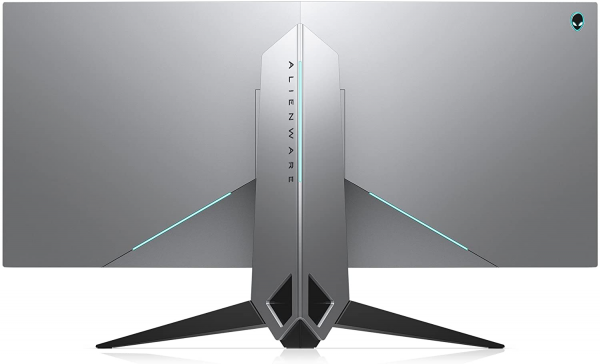
Ergonomics
The Alienware AW3418DW is well drawn. Its design is relatively simple and only the Alienware logo gives a clue to the intended target, namely the players. The 34-inch panel is matte and curved over 1.9 m, a radius of curvature greater than that of the Dell UltraSharp U3415W already tested.
The back is also master key.
Like the front, the back of the monitor is fairly standard and you have to go into the dark to finally see the different LEDs that dress the monitor and provide the visual signature of Alienware. Each zone can be configured directly from the monitor. Finally, as a final refinement, the foot has a cable management system which allows all of the connectors to come out from the rear.
The monitor is adjustable in height by 13 cm and tilt between -5 ° to + 25 °. It also manages rotation using a ball joint on ± 20 °. On the other hand, there is no pivot allowing the passage to portrait mode, which is however far from being essential on a panoramic monitor, all the more if it is curved.
The video connection is similar to that of other second generation G-Sync screens: a DisplayPort input and an HDMI 1.4 input. Only the DisplayPort can reach a frequency of 100 Hz in the native definition of 3440 x 1440 px. If the HDMI 1.4 allows a display in native definition, the frequency is limited to 50 Hz with this connection. For the rest, the Alienware AW3418DW has a headphone output, a mini-jack output and a hub with four USB 3.0 ports, two of which are conveniently placed at the base of the panel.
On our fairly standard 140 x 60 cm desk, the 34-inch Alienware doesn't look that big after all - only the depth of the foot can be a problem. Indeed, it takes 32 cm and the foot thus occupies more than half of our office.
In terms of settings, the OSD accessible via six buttons on the base of the monitor is not very practical. It often happens that you get the wrong button, but fortunately the power button is located quite far from the others. Alienware would do well to take inspiration from the Asus joystick which seems to us quite simply the most effective solution currently.
The Alienware AW3418DW consumes 44 watts on our test pattern with a white calibrated at 150 cd / m² (brightness lowered to 50). Relative consumption then reached 105 W / m², a figure slightly higher than the average of the monitors tested (100 W / m²). At a minimum of brightness (25 cd / m²), it consumes 27 W and rises to a maximum of 64 W (263 cd / m²).
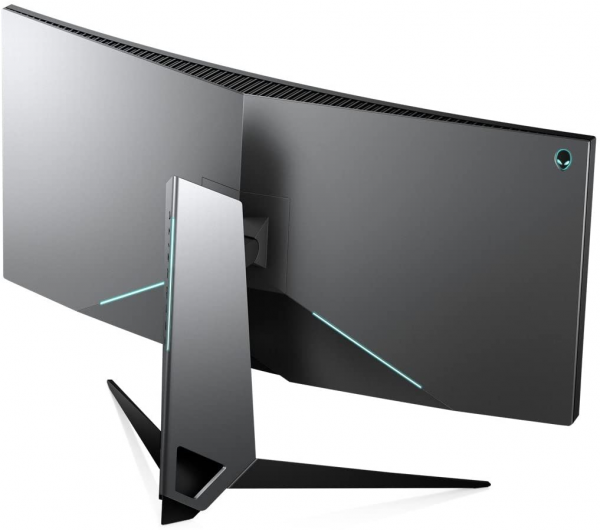
Colors and contrast
Default: average temperature at 6,600 K
Default: gamma curve at 2.4
Default: Delta E average at 3.6
By default, the rendering is far from exemplary. The temperature is certainly perfect, with a stabilized curve over the entire spectrum and an average value very close to the 6,500 K reference, but the same cannot be said of the gamma whose average is very far from 2.2 of reference, with a curve that lacks stability. This mainly results in underexposed grays. The colors can also not be considered as faithful with an average delta E of 3,6, higher than delta E of 3 above which the eye perceives the differences between the colors requested and the colors displayed.
Manual setting: average temperature at 6,610 K
Manual adjustment: gamma curve at 2.4
Manual setting: Delta E medium at 3.4
To improve things, we start by adjusting the white to 150 cd / m² (brightness adjustment to 50), but the monitor does not offer any adjustment to correct the gamma defect. The "Dark Stabilizer" option allows overexposure of the dark gray, but the curves are identical and only the colors are a little more faithful with an average delta E at 3.4.
Default: average temperature at 6,590 K
Default: gamma curve at 2.2
Default: Delta E average at 1.6
Calibrating the monitor to the probe makes it possible to perfectly smooth the gamma and temperature curves on the target values (6,500 K and 2.2). The colors also gain in fidelity with an average delta E at only 1.6, but the red, green and yellow retain values greater than 3. You can download the colorimetric profile via this link.
IPS panel requires, the contrast here is limited to 1040: 1. Some IPS monitors, especially in PLS technology, do little better (1,300: 1). In absolute terms, this contrast is weak and the blacks lack depth. This has no impact when used in daylight, but in the dark, blacks appear gray. This contrast remains very far from that measured on the best VA panels: the AOC Q3279VWF, Textorm TX32 and Philips BDM4037UW monitors, for example, exceed a rate of 4000: 1.
We also detected some light leaks in the corners. The screen still retains a very good homogeneity of the white (average deviation of only 7% over the entire 34-inch panel). Finally, it is now a habit with IPS panels, the viewing angles are excellent and there is little variation when offsetting by 45 °.
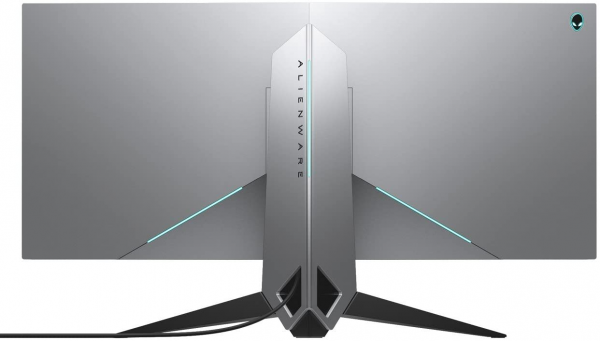
Reactivity
This screen does not use pulse width modulation (PWM or "Pulse Width Modulation") to manage the LEDs of the backlight system, which makes it possible to reduce the brightness without risking a flickering effect causing eye fatigue and headaches for people who are sensitive to them. It also has a blue light reduction mode via software adjustment.
The Alienware panel is very reactive for IPS (average remanence time of 8.5 ms). The overdrive is by default set to Normal, which reduces ghosting. By pushing the overdrive on the two upper settings, a phenomenon of reverse ghosting appears. This measurement is carried out with the refresh rate set to 120 Hz via an overclocking of the panel accessible in the settings (at 100 Hz, the remanence time is 9.5 ms). On the other hand, we regret the absence of a backlight scanning system (ULMB) which would allow better sharpness of moving objects at the expense of brightness.
Finally, the delay in display (input lag) is measured at 12.8 ms. It is a little less good than the best monitors which go down to 10 ms, but it does not affect the feeling. The delay between the generation of the image and its display on the screen remains undetectable.
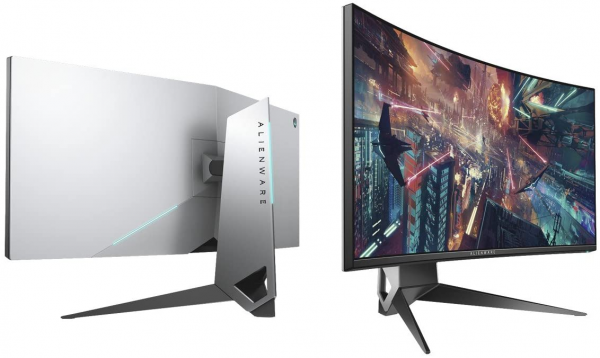
Conclusion
The Alienware AW3418DW monitor stands out from the competition by its excellent reactivity for an IPS model and its judiciously placed connectors. It suffers from a few small faults such as the lack of contrast and a perfectible factory calibration, but it will appeal to fans of the brand. The others will turn to the Acer Predator Z35P benefiting from a more contrasted and better calibrated panel.
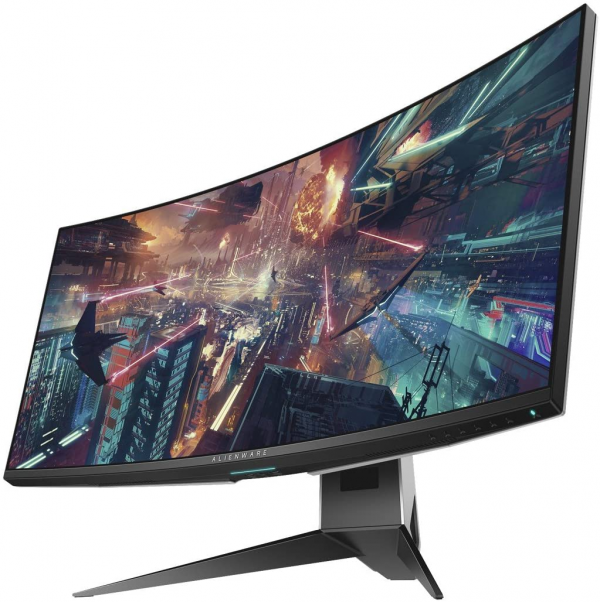
Specifications

